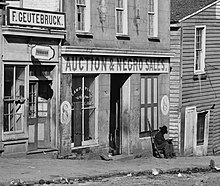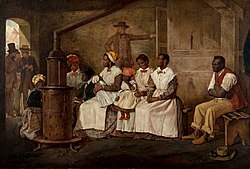Internal slave trade and forced migration
The growing demand for cotton led many plantation owners further west in search of suitable land. In addition, the invention of the cotton gin in 1793 enabled more economic processing of short-staple cotton, which could readily be grown in the uplands. The invention revolutionized the cotton industry by increasing fifty-fold the quantity of cotton that could be processed in a day. The mechanization could efficiently handle short-staple cotton, which could be grown in more places than the long-staple cotton of the Low Country. Results were the explosive growth of cotton cultivation throughout the Deep South and greatly increased demand for slave labor to support it.[42] Manumissions decreased dramatically in the South.[43] At the end of the War of 1812, fewer than 300,000 bales of cotton were produced nationally. By 1820 the amount of cotton produced had increased to 600,000 bales, and by 1850 it had reached 4,000,000.
By 1815, the internal slave trade had become a major economic activity in the United States; it lasted until the 1860s.[44] Between 1830 and 1840 nearly 250,000 slaves were taken across state lines.[44] In the 1850s over 193,000 were transported, and historians estimate nearly one million in total took part in the forced migration of this new Middle Passage. By 1860 the slave population in the United States had reached 4 million.[44] Of all 1,515,605 free families in the fifteen slave states in 1860, nearly 400,000 held slaves (roughly one in four, or 25%),[45] amounting to 8% of all American families.[46]
As the internal slave trade became a dominant feature of American slavery, individuals lost their connection to families and clans. Added to the earlier settlers' previous glossing over of origins and combining slaves from different tribes, many ethnic Africans lost all knowledge of varying tribal origins in Africa, as most had families who had been in the United States for many generations.[44]
This boom in agricultural economies in the Deep South resulted in a large westward and southward forced migration of slaves. Historians have estimated that one million slaves were moved westward and southward between 1790 and 1860. Most of the slaves originated in Maryland, Virginia, and the Carolinas, where changes in agriculture decreased demand for slaves. Before 1810, primary destinations were Kentucky and Tennessee, but after 1810 Georgia, Alabama, Mississippi, Louisiana and Texas received the most slaves.[47] Kentucky and Tennessee became exporting states.
The historian Ira Berlin called this forced migration the "Second Middle Passage", because it reproduced many of the same horrors as the Middle Passage (the name given to the transportation of slaves from Africa to North America). This large migration of slaves broke up many families and caused much hardship. The historian Peter Kolchin wrote, "By breaking up existing families and forcing slaves to relocate far from everyone and everything they knew," this migration "replicated (if on a reduced level) many of [the] horrors" of the Atlantic slave trade.[48] Characterizing it as the "central event" in the life of a slave between the American Revolution and the Civil War, Berlin wrote that whether slaves were directly uprooted or lived in fear that they or their families would be involuntarily moved, "the massive deportation traumatized black people, both slave and free."[49]
In the 1830s, almost 300,000 slaves were transported, with Alabama and Mississippi receiving 100,000 each. During each decade between 1810 and 1860, at least 100,000 slaves were moved from their state of origin. In the final decade before the Civil War, 250,000 were moved. Michael Tadman wrote in Speculators and Slaves: Masters, Traders, and Slaves in the Old South (1989) that 60–70% of interregional migrations were the result of the sale of slaves. In 1820 a child in the Upper South had a 30% chance of being sold south by 1860.[50] The death rate for the slaves on their way to their new destination across the American South was much less than that of the captives shipped across the Atlantic Ocean, but mortality was higher than the normal death rate.
Slave traders transported two-thirds of the slaves who moved west.[51] Only a minority moved with their families and existing master. Slave traders had little interest in purchasing or transporting intact slave families; in the early years, planters demanded only young male slaves for heavy labor. Later, in the interest of creating a "self-reproducing labor force", planters purchased nearly equal numbers of men and women. Berlin wrote:
The expansion of the interstate slave trade contributed to the "economic revival of once depressed seaboard states" as demand accelerated the value of slaves who were subject to sale.[53]
Some traders moved their "chattels" by sea, with Norfolk to New Orleans being the most common route, but most slaves were forced to walk overland. Others were shipped downriver from such markets as Louisville on the Ohio River, and Natchez on the Mississippi. Traders created regular migration routes served by a network of slave pens, yards, and warehouses needed as temporary housing for the slaves. In addition, other vendors provided clothes, food, and supplies for slaves. As the trek advanced, some slaves were sold and new ones purchased. Berlin concluded, "In all, the slave trade, with its hubs and regional centers, its spurs and circuits, reached into every cranny of southern society. Few southerners, black or white, were untouched."[54]
Once the trip ended, slaves faced a life on the frontier significantly different from most labor in the Upper South. Clearing trees and starting crops on virgin fields was harsh and backbreaking work. A combination of inadequate nutrition, bad water, and exhaustion from both the journey and the work weakened the newly arrived slaves and produced casualties. New plantations were located at rivers' edges for ease of transportation and travel. Mosquitoes and other environmental challenges spread disease, which took the lives of many slaves. They had acquired only limited immunities to lowland diseases in their previous homes. The death rate was so high that, in the first few years of hewing a plantation out of the wilderness, some planters preferred whenever possible to use rented slaves rather than their own.[55]
The harsh conditions on the frontier increased slave resistance and led owners and overseers to rely on violence for control. Many of the slaves were new to cotton fields and unaccustomed to the "sunrise-to-sunset gang labor" required by their new life. Slaves were driven much harder than when they had been in growing tobacco or wheat back east. Slaves had less time and opportunity to improve the quality of their lives by raising their own livestock or tending vegetable gardens, for either their own consumption or trade, as they could in the east.[56]
In Louisiana, French colonists had established sugar cane plantations and exported sugar as the chief commodity crop. After the Louisiana Purchase in 1803, Americans entered the state and joined the sugar cultivation. Between 1810 and 1830, planters bought slaves from the North and the number of slaves increased from less than 10,000 to more than 42,000. Planters preferred young males, who represented two-thirds of the slave purchases. Dealing with sugar cane was even more physically demanding than growing cotton. The largely young, unmarried male slave force made the reliance on violence by the owners "especially savage."[57]
New Orleans became nationally important as a slave market and port, as slaves were shipped from there upriver by steamboat to plantations on the Mississippi River; it also sold slaves who had been shipped downriver from markets such as Louisville. By 1840, it had the largest slave market in North America. It became the wealthiest and the fourth-largest city in the nation, based chiefly on the slave trade and associated businesses.[58] The trading season was from September to May, after the harvest.[59]
Slave traders were men of low reputation, even in the South. In the 1828 presidential election, candidate Andrew Jackson came under heavy attack as a slave trader who bought and sold slaves and moved them about in defiance of modern standards or morality. He was not attacked for merely owning slaves used in plantation work.[60]



No comments:
Post a Comment